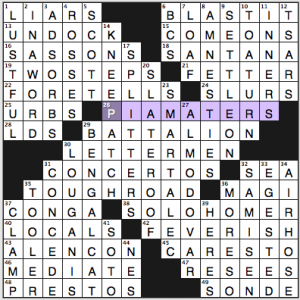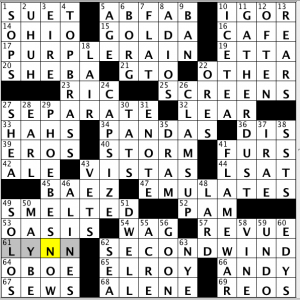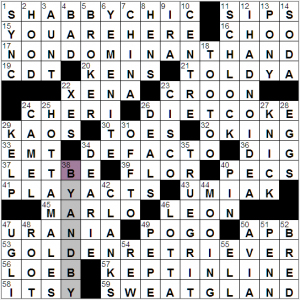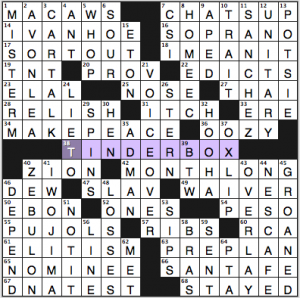NYT 7:16
Newsday 6:39
LAT 8:05 (pannonica, not fully awake)
CS 5:36 (Dave)
Tim Croce’s New York Times crossword
A word count of 58? Huh. That explains why I did not particularly enjoy this puzzle.
Granted, there are some entries I enjoyed seeing:
- 16a. [“Oo la la!” jeans, informally], SASSONS. It is a dreadful answer, I know. Plural of an ’80s designer jeans brand name? But! I had Sassons. They were corduroy. In a dark taupe. They enhanced my wardrobe, which also included Calvin Klein and Gloria Vanderbilt jeans.
- 38a. [Round trip for one?], SOLO HOMER. Baseball. The season is almost over! Rejoice, all.
- 14d. [Remedy for a bad leg], KNEE PATCH. This takes me back to my pants of the ’70s. There was a time when iron-on or sew-on patches were all the rage.
- 27d. [2002 Best Original Screenplay Oscar winner for “Talk to Her”], ALMODOVAR.
- 29d. [Spotted hybrid house pet], BENGAL CAT. Bred by mating an Asian leopard cat with a domestic cat.
- 30d. [1980s Olympic star with the autobiography “Breaking the Surface”], LOUGANIS.
- 32d. [Geisha’s instrument], SAMISEN. It’s a pretty word, and crossword-friendly to boot.
The interlock of all the 9-letter answers in the middle is pretty, but that pinwheel spins off some roll-your-own entries, such as UNDOCK, RESEES, and TOOLER, as well as some unexpected plurals (PIA MATERS, PRESTOS, ROSSES, AMNESTIES, INNERS). Is any puzzle improved by the presence of any of these eight entries?
My eyeballs hurt, so I’ll sign off here for the night. Tough puzzle, no? Not crazy-hard like so many Newsday “Saturday Stumper” crosswords, but it definitely took some work to piece everything together. How’d it treat you?
3.25 stars.
Bruce Venzke’s CrosSynergy / Washington Post crossword, “Weather Worries” – Dave Sullivan’s review
Four theme entries (well five, if you count the middle revealer) that end with a type of storm:
- [Smash hit by Prince in 1984] was PURPLE RAIN – and I wanted Raspberry Beret at first.
- [New burst of energy] clues SECOND WIND – we had some serious windstorms here in Vermont last week. An old maple on our property (probably over 100 years old) came down and took down an electric pole with it.
- [Be unused for a long time] was GATHER DUST – I think “collect” is a bit more idiomatic. Dust storms remind me of the Peanuts character Pig-Pen.
- [“Poetry Man” singer] clues PHOEBE SNOW – only vaguely familiar with this singer; here’s her Poetry Man.
Theme was just okay in this one, but the “pinwheel” theme configuration allowed some nice medium-length fill to hold the puzzle together. I’m talking about the current FLAME WAR, TOP BRASS and CLAMS UP. I also liked the SUET / LARD one-two fat punch. I was a bit surprised to see ICE TEA get a British reference in the clue; I guess on this side of the pond we typically call it ICED TEA, but I think the former is also in currency here. I’m torn between awarding my UNFAVE to SSTS or the uncommon E-NOTE, so we’ll just call that one a toss-up for now.
Brad Wilber and Doug Peterson’s Los Angeles Times crossword — pannonica’s write-up
Tough but rewarding Saturday offering, but further-but not too tough. Found it much easier and more enjoyable than, say, today’s NYT crossword.
A well-filled grid, great cluing, one really couldn’t ask for more. Also, sleepy me must have fallen into every trap. So let’s review the experience by reliving my every slip most every slip I made, why don’t we?
- Over at 27-down I was so proud of myself for knowing a sports answer without any crossings: famed “Zen” coach Phil Jackson played basketball as a New York KNICK for most of the ’70s. Then I zinged 40d [Success on a mat] PIN. This naturally led to 43a (Yupik craft] ––I–K. What? It’s obviously KAYAK, so out goes PIN and the I … Of course I forgot about the classic UMIAK, and PIN had been correct from the start.
- 47d [Jamaican hybrid fruit] Classic contemporary crossword fill: UGLI! Bam, leading to 47a [Astronomy Muse] beginning with U, so in went URANUS. Have I mentioned that I wasn’t completely awake? In the same area, with the UGLI L in place, I nailed 56a [Singer of the children’s album “Camp Lisa”] as LOEB. This was horribly counteracted by being completely fooled by the surname shenanigans in 45a [Thomas who co-created “Free to Be… You and Me”]—you know, the much more famous children’s album from my actual childhood? Gah, curse you MARLO Thomas! (You’re still ok, URANIA.)
- 1d [What collaborators should be in] at four letters, TUNE, duh. No, SYNC, duh. Similarly, and again in UGLIville, 58a [Minute] I––– for ITTY, natch. Ahem, ITSY.
- 51d – At least I was wise enough not to automatically put down YALE for the four-letter [Ivy league member]; it turned out to be PENN. One in a row!
- 28d EGGS, clued as [Early birds?], which is a venerable if slightly hoary crossword clue. Nevertheless, I managed to be completely bamboozled by it, wondering about everything from Archaeopteryx to mourning doves.
- 32a [Authorizing]. Oh right, this one. Just didn’t see it properly; was bizarrely thinking that it was a rather silly and arbitrary variation of “authoring.” Writimating, anyone? OK-ING.
- Had enough? I think you get the idea.
- Oh, here’s another. 54d [FF’s opposite]. Seemed reasonable that it was PPP, very piano and not forte. But it was REW(ind), in contrast to fast forward.
Moving forward from the litany of mishaps, let’s have a more conventional look. Some great long fill: two 15-letter spanners to help anchor the grid, NON-DOMINANT HAND [It’s hard to write with one] and GOLDEN RETRIEVER [Hunter’s companion], then HOT TAMALES and the exclamatory I HAD NO IDEA, as well as the precisely stacked (and excellent) SHABBY CHIC (lovely opener at 1-across) / YOU ARE HERE and KEPT IN LINE / SWEAT GLAND.
Notes:
- Well-executed cross reference with that YOU ARE HERE, directed to the nearby 22d XES.
- Smartly avoided cross-reference: 49d [Star of Looney Tunes’ “For Scent-imental Reasons”] PEPÉ; 24a [Word in a Le Pew address] CHÉRI. All right, appealing to actual francophones here: shouldn’t it be CHÉRIE, as the object of his desire, while of a completely different genus, is indeed female? Although, considering Monsieur Le Pew’s bastardized faux-French, it probably doesn’t matter. Side note: Warner Bros would have been somewhat more progressive if the unfortunate white-striped feline was occasionally a male cat, non? Obviously, I’m making this observation retrospectively. Besides, Bugs and Daffy never hesitated to tog up in drag for amorous liaisons when it suited their needs.
- 6d [Dweller on the Red Sea] YEMENITE, versus YEMENI? Thoughts?
- 37a LET BE crossing 38d BY AND BY. Though neither is clued in any way musically, I instantly imagined a mash-up of the Beatles’ “Let it Be” and the Nitty-Gritty Dirt Band’s “Will the Circle Be Unbroken.”
- 34d [Toots] DEARIE. This was asked elsewhere recently: how well-known is Blossom Dearie?
- 11d [Cheesy stuff] SCHLOCK. How can it be schlock when it’s more than 85% consonants? So, file this one under HETEROLOGICAL with “monosyllabic,” “unwritten,” and others.
- Finally, in the CENTRE (10d) is 34a [In reality] DE FACTO.
And this crossword is a DE FACTO winner.
Lars Doubleday’s Newsday crossword, “Saturday Stumper” (Doug Peterson and Brad Wilber)
Team Brohug is back with a second themeless today. I really liked their LAT puzzle, and their “Stumper” landed smack-dab between the LAT’s and NYT’s difficulty levels. I preferred their LAT to this, actually, what with all those zippy 10- and 15-letter answers. There’s less spice in a puzzle that’s dense with 7s.
Favorite clues:
- 16a. [Italian for ”what is above”], SOPRANO. I did not know that! Terrific etymology clue.
- 23a. [Fleet with stars on its tailfins], EL AL.
- 25a. [Photo finish focus, maybe], NOSE. Not matte vs. glossy, but a photo finish where one horse wins by a nose.
- 47a. [Dalmatian, for example], SLAV. Dalmatia is a region of Croatia.
- 3d. [Radio show with a wrench in its logo], CAR TALK. Fresh but gettable. It’s now an erstwhile show, no?
- 7d. [TV vehicle for Justin Bieber], CSI. The Bieb was on CSI??
- 11d. [Top-10 surname in Spain], SANCHEZ. My cousin picked up the Sánchez surname by marriage.
- 21d. [Element of much film noir], VOICEOVER.
- 44d. [Brand whose success was groundless?], NESCAFE. Instant coffee, in some mystical form that is not coffee grounds. (What is it?)
- 56d. [Bunch of waiters], LINE. As in the bunch of people waiting in line for new iPhones yesterday.
- 64d. [National grp. since 1897 that elected its first male head in 2009], PTA. Interesting trivia clue.
Favorite fill includes TINDERBOX and ZEBULON Pike.
Not wild about:
- 1d. [Call a bad name], MISTERM. I have never used this word.
- 5d. [Bash], WHOP. This just looks wrong to me. Wanted WHAM, then WHAP. Mind you, WHOP dates back to late Middle English and is still in use now, and is thus unimpeachable as crossword fill. It’s both a noun and a verb.
- 6d. [Captious], SOUR. I dunno. Is a captious person who nitpicks necessarily SOUR? Perhaps so.
Four stars.





NW was the last to fall and I wanted ass pants for “Oo la la!” jeans for some reason.
SAMISEN/SONDE was too heavy a lift for this lightweight.
Moments I did enjoy: the INAWORD/INSHORT misdirection! TOATURN. BENGALCAT. That’s precious little pay-off for awkward plurals and roll-your-own words. (I’m counting artificial plurals in that tally.) Tim Croce is a talented grid-filler, but a grid like this gives solvers little reward.
I agree with Gareth–lots of awkward stuff. I knew ALMODOVAR but had to use Google to get a foothold in many places. 31A was a really long word to clue with a cross-reference, leaving an empty space for a long time.
I wanted [PRODUCES LUSH SOUNDS?] to be BURPS. Does that pass the breakfast test?
I had __URS and wanted it to be POURS thinking that a “lush” would be happy to hear the sounds of glasses being filled.
Whew! That NYT was a slog. Slow time for me. I don’t mind hard, but the payoffs on this one were few and far between. Too many convoluted entries to really enjoy, although remembering how to spell Pedro ALMODOVAR’s name was a pleasant moment.
Well, I finished the NYT (with a single incorrect Hail Mary at the intersection of ALENCON and NES–hey, I don’t tat and I don’t game), but it didn’t make me happy. Too many answers teetering on the line between acceptable esoterica and outright abuse of the language (UNDOCK? TOOLER??). And is SMARTALEC really an acceptable alternative spelling? I’ve always seen it with a K at the end. SOLOHOMER was nice, though.
Gary — Yes, but . . .Alençon is somewhat well known as a French city, and it *is* famed for lace, though not everyone would know that. When I lived in Versailles, we would visit the Chartres cathedral regularly, and the ladies from Alençon (not far to the west) would have set up little tables on the front steps selling their lace, and I became quite fascinated by the intricacy and delicacy, even as a kid.
NYT: Beautiful grid. I just loved looking at it before trying my hand at solving it. Did most of it last night but parked it and finished this morning. Thank goodness for PIA MATERS– I plunked it down immediately and it opened the center for me. Same with ALENCON– having two immediate gimmes hardly ever happens to me on a Saturday.
When I saw -IA-S at 1A, I guessed DIAGS for diagonals, especially that there was a contraction in the clue. Technically they are straight lines but they don’t go straight up and down, right? Shows how twisted a mind can get when dealing with a Saturday puzzle.
I wish the cluing had been a bit more playful. It had its moments of course, but at some point I thought I should try the more literal meaning and it worked more often than not.
Agreed! Visually stunning. Sure, a couple of clunkers, but what a nice change of pace type puzzle.
pannonica –
“YEMENITE, versus YEMENI? Thoughts?” – I really rationalized “Yemenete” because I was a French major. I had “chere” for CHERI, since I thought it should be “cherie.”
I’m thinking “crystals,” whatever they might actually be (probably grounds).
This came up in sidebar:
It’s “ground coffee” until it’s been brewed, at which point you have coffee and “coffee grounds.” N’est ce pas?
I absolutely loved the NYT — way more than the consensus. Tough, but not quite as hard for me as yesterday. It becomes clear to me that I value what I consider real originality, freshness, novelty, much more than many, and I am much more tolerant of what others deride as clunky fill, in aid of that virtue. I do think there is something to be said for something I suggested previously — that people *like* seeing the same thing over and over again, even while grumbling about the basic “oreo – oslo” routine.
I thought the stacking of 26, 29, 30, 31 and 35a was stunning (though I had to correct “rough to “tough” road.” I loved the cross reference of concertos and prestos. “Battalion” is indeed correctly clued. The commandant of a battalion is generally a Lt. Col, and of a regiment, a full colonel. I loved the cluing of 42a, 38a ,14d. I loved 19a. Joplin did classify his rags as “one steps” two steps” “cakewalks” “concert rags”, with some unclassified. The distinctions are subtle. (Maybe too subtle for me.) I love Pedro Almodovar’s funny, irreverent sexy movies. I love the sound of the samisen. There was enough to love in this puzzle for 2 or 3 puzzles. 5 easy stars.
Much harder for me today than yesterday. I thought it was a brilliant puzzle with two shortcomings: RESEES and too many plurals.
Steve
I was disappointed to learn from Deb’s Wordplay post that the NYT constructor used constructing software auto-fill to fill his puzzle. Really? Sigh.
All your fill are belong to us.
Don’t the vast majority of constructors use the computer as a crutch, (or more accurately, use the computer to do most of the work?) I try to ignore this, and dig my head into the sand, inasmuch as I regard the intrusion of the computer into most human activities — intellectual, personal, social, emotional, recreational — as perhaps the greatest, most insidious disaster of the modern world.
I was not surprised to see a comment like this here, but I did a double take when I saw who posted it.
To my mind there are two related but very different skill sets that constructors must have to fill grids well: finding fill possibilities and good taste. A constructor must not only be able to find words or word-like strings that will fill in all of the white squares (by whatever means), but must also be able to decide which sets of possible words are good and which are not. Amy, since your reviews suggest that you are resolutely indifferent about the first skill while focusing almost entirely on the second, I’m surprised that you care at all how the fill possibilities are actually found. Would your feelings about the puzzle have been any different had you learned that he filled it entirely “by hand”?
Not intended as an attack, btw; you’re entitled to feel however you feel about the puzzle and its construction, of course. Legitimately curious.
Glad you inquired, bananarchy!
There are people who meticulously, laboriously curate their own word lists, adding interesting new finds and scoring every entry. Frank Longo and Peter Gordon are two who come to mind here. Because they put in the effort up front to define what sort of fill they value and what sort is filler junk, when they let Crossword Compiler fill a grid with a certain minimum word score, their results are likely to be excellent. (How often do I complain about lousy fill in the Fireball? Pretty much never. Peter Gordon demands the best of himself and of his contributors.)
There are people who have somewhat less robust word lists than Frank and Peter, but who are likely to choose the “manual” auto-fill process in Compiler. With manual, you choose each entry from a list of possibilities, shaping the content as you go along, backing out of your choices if they force you into unwelcome junk fill. I don’t have an issue with this.
There are the super-genius constructors like Matt Gaffney and Trip Payne, who work on paper. Everything that goes into their puzzles, they’ve chosen to put there. No auto-fill at all. (Yes, they’ll use constructing software to output their finished work, as no publisher or solver wants to receive a sheet of graph paper.) I believe gifted constructors like Byron Walden and Brendan Quigley do much of their constructing with Crossword Compiler, but plunking down black squares and filling in white squares manually, starting with seed entries and proceeding with the ideas in their head. They might use onelook.com to generate a list of words that will fit a particular letter pattern, but aren’t asking Compiler to fill anything in for them.
“I pressed auto-fill and wow, I was pleased with the results” does not impress me in the slightest.
Filling a puzzle entirely by hand and putting roll-your-own words in? Also doesn’t impress me. I don’t see the point of maintaining a low word count (or making other sorts of “stunt” grids) with iffy words.
I’d like to ask Matt Gaffney (or others who are so inclined) to expound on the hallmarks of auto-filled grids vs. hand/mind-filled. In themed puzzles, I think it’s largely the appearance of a lot of junky, boring crosswordese that he finds it hard to believe anyone would intentionally, purposefully place in a grid.
Amy,
My understanding is that both Merl Reagle and Henry Hook have relatively low reliance on computerized fill. Do you know if this is so? (Merl and Henry can answer for themselves, if they wish.)
Thanks for the thoughtful response!
Again, though, this all comes down to the taste and artistry of the constructor, and not their grid-filling aptitude or methods. A constructor could spend as long as Frank Longo has manicuring their own wordlist, but if their ranking and inclusion choices are poor then so will be their puzzles. The crosswordese-heavy themed puzzles you mentioned are most likely made using auto-fill to some extent, but I think it’s correlation and not causation at work here: these puzzles are likely made by less experienced constructors who might not be able to fill their grid any better by “purposefully” selecting each word themselves. Their choice of methods isn’t what causes of subpar grids, but it is probably correlated with their lack of mastery when it comes to choosing a balanced set of solid entries.
By the way, I’m including myself in the “they” of which I speak :)
I’m about 50% paper and 50% on Crossword Compiler, though I only occasionally use autofill, like when I can’t crack a corner. Certainly not on an entire puzzle or even a big part of a puzzle. I don’t have a good database anyway so there’s not much to be tempted by.
Bananarchy — you’re right, there’s nothing inherently wrong with autofilling a themeless grid. It’s somewhat annoying to me personally as someone who used to enjoy writing themelesses by hand before the computers took over, since that skill is now severely diminished (that’s why I’ve written I think a total of two themelesses in the past 12 years). But that’s progress and the overall quality of themelesses is way higher now for it.
In my view, the problem with a grid like today’s NYX is that there’s not much zing to the entries since the focus was on getting a very wide-open grid and a very low word count. There’s not a single X, Q, Z or J in the whole thing, and just one K. Some good stuff, sure, but compare the top 5 entries in this grid to the top 5 in a BEQ or Byron Walden freestyle and you’ll see a big difference.
Let me test that hypothesis blind by taking my 5 favorite entries from the Croce and from last week’s BEQ Monday themeless, which I haven’t seen so I’m not cherry-picking.
Croce: SOLO HOMER, SLATE ROOF, ALMODOVAR, LUSTFUL, FEVERISH. (not picking SMART ALEC since it looks better with a K, though it is acceptable without)
Quigley: I STARTED A JOKE, JUJYFRUITS, ARE YOU OK?, FIRETRUCK, BIG PAPI.
So I think there’s a clear winner there — none of the NYX ones are marquee entries, but Brendan’s has several. If you expanded the list to top 15 entries the difference would be even starker.
The whole point of a themeless is that, taking advantage of the removed theme constraints, the vocabulary should shine like a supernova. This is what makes freestyles by Byron, Josh Knapp, Brendan, Matt Jones, etc. so fun to solve. When the focus moves over to low word count and a wide-open grid, I’m not as big a fan of the results. That doesn’t exclusively happen with autofilled grids, but it skews hard that way.
An even better example is the Wilber/Peterson LAT today, a themeless that’s overflowing with marquee entries. Seriously doubt it was autofilled.
For some reason I can’t reply to MG’s comment (perhaps there’s a limit on the depth of nested comments?), but this is in response to it:
I kind of group freestyles like Tim Croce’s into a different category than, say, typical BEQ/Wilber/Peterson offerings. I agree that the vocab in the NYT isn’t nearly as zippy as the others you cited, but the structure of the grid itself provides a different sort of challenge that you don’t get with tighter, more scrabbly freestyles. At least from this solver’s perspective, cracking those vast expanses of white squares demands more of one’s faculties of deduction and inference, and they also call for a lot of risk-taking which can make for an exciting solve. On the other hand, freestyles with more modest grid layouts but punchier vocab can provide a few more smiles as the fresh words are unearthed. I enjoy both styles equally (my paper solving regimen lately has consisted of alternating between a Longo freestyle book and the Fireball freestyle book, for instance). Since most of these terrifyingly-wide-open monstrosities wouldn’t exist without autofill, I, for one, welcome our new electronic overlords.
37a LET BE crossing 38d BY AND BY. Though neither is clued in any way musically, I instantly imagined a mash-up of the Beatles’ “Let it Be” and the Nitty-Gritty Dirt Band’s “Will the Circle Be Unbroken.”
Thanks for my laugh of the day! And also battling earworms.
“Speaking words of wisdom … in the sky, Lord, in the sky”
Bruce, it’s an interesting perspective, viewing the use of computers as insidious disaster when it’s letting us all engage in this interesting forum, for example. I do understand the negative impact of computers on so many aspects of life, but I see it as a double edged sword, and the good edge, in my view, outweighs the bad one. Certainly in the research and science business, it has opened up untold frontiers, including a better understanding of the human mind. May be the fault is in all of us, in how we allow things to take over our lives.
Definitely a double-edged sword and also a source of paradox — e.g. using a computer to inveigh against computers.